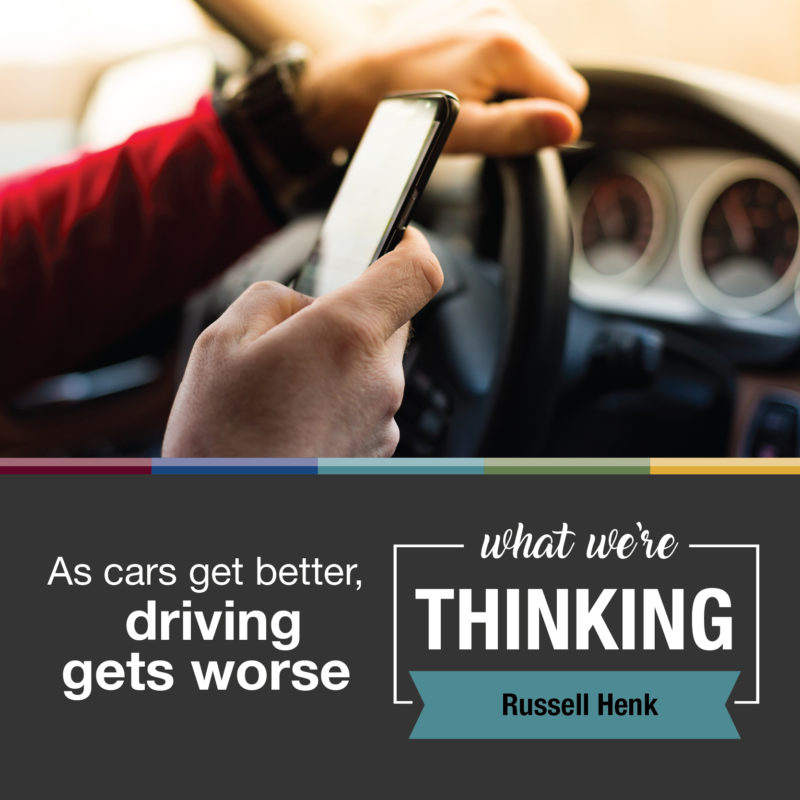Our cars keep getting better, but our driving seems to be getting worse.
Auto design has evolved from safety belts and airbags that help us survive crashes to features like lane-departure warnings and automatic emergency braking that help us avoid them. Still, the rate of distracted driving deaths rose twice as fast as overall crash deaths in the first half of this decade, according to the Centers for Disease Control and Prevention. You could argue that human intelligence isn’t keeping pace with artificial intelligence.
Developing driver IQ, of course, begins at a very young age. And so does smartphone ownership.
A Nielsen study in 2017 found that nearly half of kids got their first smartphones when they were 10 to 12 years old. They will have had five or six years to perfect their wireless skills, creating what amounts to a functional addiction, by the time they reach legal driving age. Scary.
Fortunately, teenagers no longer flock to driver’s license offices to secure permits right away. In fact, a growing number of those eligible to drive at age 16 are instead waiting until they turn 18, deterred mostly by a lack of interest in driving and an aversion to its cost. This means two more years of maturing and brain development (handy in making critical judgments about driving risks), but the newest drivers aren’t gaining the benefit of learning to drive under safer conditions afforded by graduated driver licensing laws.
We know that new drivers benefit from at least 12 months of supervised on-road experience to establish basic driving abilities. That doesn’t change simply because they wait two years to start driving. Recent data indicate that longer-term crash rates are actually higher for those for those who wait until age 18 than for those who start driving when they’re 16 or 17.
And, two years waiting to venture out as a new driver is also two years spent growing more comfortable with – and addicted to – a smartphone. In recent years, texting while driving among 18- to 29-year-old drivers actually declined modestly from 71 percent to 58 percent. But at the same time, those who browsed social media websites while driving nearly doubled, jumping from 21 percent to 41 percent. The number who posted on those sites while driving grew from 20 percent to 30 percent. Smartphone task management is becoming more complex for younger and less-experienced drivers, requiring more of their attention and effort.
Considering all of that, it’s easy to assume that distracted driving is a youth-only problem. But it’s not. Even though adults (example-setting parents in many cases) may have mastered vehicular operation, they may botch even the most basic smartphone functions. When that fumbling happens behind the wheel, safe driving experience means little.
If we’re expending more time and attention on distractions, we’re investing less in the driving task. It’s a zero-sum proposition.
To stop this, we’ve long relied on traditional strategies of laws and associated penalties, parental restrictions, and more recently, peer influence. But new research suggests we may have a new motivator: hamburgers and pizza.
The Teens in the Driver Seat Program, developed by the Texas A&M Transportation Institute, launched a smartphone app in 2016 that awarded prizes for distraction-free driving. We found significant reductions in distracted driving when teen drivers focused on those rewards (including food) rather than their smartphones.
Distracted driving is an issue for everybody, but more so for teenagers as they form lifelong driving patterns. We can only hope that those habits don’t lead them to fail the driver IQ test.
Russell Henk is a senior research engineer and manager of the youth transportation safety program at the Texas A&M Transportation Institute. He wrote this column for The Dallas Morning News.
This article was originally published in the The Dallas News, April 11, 2019.
